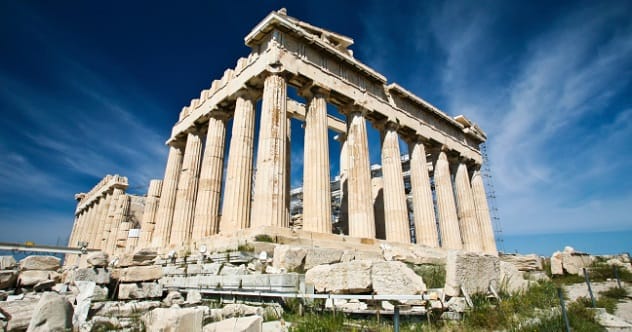The ancient world is full of incredible structures that stand as testaments to human ingenuity and skill. From towering pyramids to massive temples, these buildings continue to fascinate us. While many travel to see famous monuments such as the Eiffel Tower or the Great Wall of China, numerous lesser-known ancient structures are equally impressive.
Let’s explore ten often-overlooked but unbelievably fascinating structures, each with a unique story to tell.
The Great Bath of Mohenjo-daro
The Great Bath of Mohenjo-daro is an extraordinary engineering achievement that has captivated historians and archaeologists. Believed to have been used for ritual bathing and social gatherings, it was a vital part of the Indus Valley Civilization’s religious and cultural practices.
Located within a large citadel complex discovered in the 1920s, the bath is considered one of the central features of the Indus civilization. Surrounded by a courtyard, it includes steps leading down to a pool measuring approximately 12 x 7 feet (3.7 x 2.1 meters) and a depth of 2.5 feet (0.76 meters).
One of the most remarkable aspects is its advanced drainage system, featuring sophisticated drains that collected and reused water for ritual purification. This system represents some of the earliest examples of urban planning and engineering, showcasing the Indus Valley Civilization’s architectural skills.
The Step Pyramid of Djoser
The Step Pyramid of Djoser stands as a testament to the power and ingenuity of ancient Egypt. Built over 4,600 years ago for the pharaoh Djoser, it is considered the world’s oldest surviving stone structure. The architect Imhotep created its unique design by stacking mastabas (flat-roofed tombs) to form a pyramid shape.
Originally reaching a height of 205 feet (62.5 meters) and constructed with over 6 million blocks of stone, the Step Pyramid represents an impressive feat of engineering and architecture. It symbolizes Djoser’s authority and marks the beginning of pyramid construction in ancient Egypt, serving as a burial site for pharaohs.
Despite its age, the pyramid continues to attract visitors worldwide, reminding us of the incredible achievements and lasting legacy of the ancient Egyptians.
The Ziggurat of Ur
The Ziggurat of Ur is a stunning example of Mesopotamian architectural and religious structures. Built around 2100 BC by the Sumerians, this ancient temple tower was dedicated to the moon god Nanna. Originally, it stood over 98 feet (30 meters) tall, featuring a mud brick core and a baked brick exterior.
Visitors would climb a staircase to reach the top, making it one of the highest points in the city and visible for miles. The Ziggurat played a significant role, as a religious structure and a symbol of power and authority.
Commissioned by King Ur-Nammu of the Third Dynasty, its construction served to legitimize his rule and demonstrate his power over the people of Ur. Today, it remains an essential historical site, showcasing the architectural achievements and religious beliefs of the ancient Mesopotamians.
The Bath in Hisham’s Palace at Jericho
The bath in Hisham’s Palace in Jericho, Israel, is believed to be the world’s oldest known bathhouse, dating back to around 2000 BC. Used for religious ceremonies and social gatherings, this ancient structure provides valuable insight into the bathing rituals and social practices of early civilizations. Its importance lies in its role in the evolution of these societies.
Hisham’s Palace covers approximately 150 acres (60 hectares), including the palace, a mosque and courtyard, and the bath. The bath was particularly impressive, housing an audience hall used as a throne room.
Heavily decorated, the bath hall features some of the earliest and largest mosaic panels from Islamic architecture’s classical period. The most famous panel depicts a lion attacking a gazelle beneath a tree, making the bathhouse famous among historians of Islamic art.
Pyramid of Cheops
The Pyramid of Cheops, also known as the Pyramid of Khufu, was built around 2560 BC and is the oldest and largest of the three pyramids at Giza, Egypt. Standing at 481 feet (146.6 meters) with sides measuring 738 feet (225 meters), this limestone and granite pyramid is considered the most perfect of the Giza pyramidsDue to its near-perfect square shape and orientation to the four cardinal directions.
Built as a burial site for Pharaoh Cheops (Khufu), its impressive size and design continue to amaze people today. The Pyramids of Giza were constructed as burial sites for pharaohs during the 4th Dynasty in ancient Egypt (2575–2465 BC).
These structures, known for their architectural feats, represent the cultural and historical significance of the ancient world and also stand as a testament to the innovation and creativity of ancient civilizations.
Angkor Wat
Angkor Wat is a magnificent temple complex located near Siem Reap, Cambodia. Built during the 12th century by King Suryavarman II, it includes over a thousand buildings across 402 acres (172 hectares). Constructed in the capital of the Khmer Empire, the temple complex took approximately 30 years to complete and was originally dedicated to the Hindu god Vishnu before becoming a Buddhist temple by the end of the 12th century.
A UNESCO World Heritage Site, Angkor Wat is considered one of the most important archaeological sites in Southeast Asia. It stands as a symbol of both Hindu and Buddhist religions and is an amazing representation of Khmer architecture.
Visitors can explore intricate carvings and sculptures depicting religious and daily life scenes. Angkor Wat continues to inspire and awe visitors worldwide, truly a marvel of human achievement.
Christ the Redeemer
Christ the Redeemer is a cultural and religious icon known worldwide. The statue is significant not only for its size and beauty but also for its location and history. Standing on Corcovado Mountain in Rio de Janeiro, Brazil, it reaches 98 feet (30 meters) tall, with arms spanning 92 feet (28 meters). Completed in 1931, it symbolizes Brazilian identity and national pride.
As a UNESCO World Heritage Site and one of the Seven Wonders of the World, it is a symbol of Brazil’s rich history and serves as a platform for significant events. The statue attracts millions of tourists every year.
The original idea was conceived in the 1850s, but plans were not implemented until the 1920s. The Roman Catholic archdiocese in Rio and a group of locals hoped that placing a massive statue of Jesus on a mountain would counter the perceived “lack of religious faith.”
Colossus of Rhodes
The Colossus of Rhodes was an impressive work of art and engineering with a significant impact on the ancient world. Standing 110 feet (33.5 meters) tall, it was one of Rhodes’s most important landmarks, a bustling trading port in the Mediterranean. As one of the Seven Wonders of the Ancient World, it symbolized power and prestige.
The Colossus was built by the people of Rhodes to celebrate their successful resistance against a powerful army after the division of Alexander the Great’s empire. The giant statue of the Greek god Helios was erected by Chares of Lindos between 292 and 280 BC but was destroyed in an earthquake in 224 BC.
Despite its brief existence, the Colossus of Rhodes remains awe-inspiring. Its story speaks to the ingenuity, creativity, and perseverance of ancient civilizations. Today, visitors can witness remnants of this magnificent statue and appreciate its historical significance.
Chichen Itza
Chichen Itza is an impressive ancient Mayan city in south-central Yucatan state, Mexico, covering 4 square miles (10.3 square kilometers). Its most remarkable feature is the ball court, the largest in the Americas, measuring 554 feet (168 meters) long and 231 feet (70.4 meters) wide. Ritual games were played here, testing the players’ skills as they tried to hit a 12-pound ball through stone rings.
Steeped in cultural significance, Chichen Itza boasts impressive architecture and an intriguing history. Inhabited from AD 550, it served as a political, religious, and commercial center, with a peak population of 35,000 people.
The stunning El Castillo pyramid, Temple of the Warriors, and Sacred Well are must-see structures showcasing Mayan architectural expertise. As one of Mexico’s most visited tourist destinations, Chichen Itza provides a fascinating insight into the region’s rich history and culture.
Acropolis of Athens
The Acropolis of Athens is an iconic symbol of ancient Greek civilization, featuring temples such as the Parthenon and the statue of Athena created by Phidias. Constructed in the 6th century BC, it remains a popular tourist attraction, drawing visitors worldwide. Rising 500 feet (152 meters) above sea level, the Acropolis sits on a rocky hill measuring approximately 557 x 1,150 feet (170 x 350 meters).
The natural center of Athens, Greece, the Acropolis has been a World Heritage site since 1987. Its steep sides, save for the western approach, and nearby springs made it an obvious choice for the ancient Greeks. The Acropolis and other significant cultural and historical bequests have left a lasting impression on the world and continue to influence Western architecture.
These ancient structures remind us of the incredible achievements of past civilizations. Each site offers a unique glimpse into the lives, beliefs, and skills of the people who built them, leaving a lasting legacy that continues to inspire us today.
Which of these ancient structures fascinates you the most? Leave your comment below and share your thoughts!










